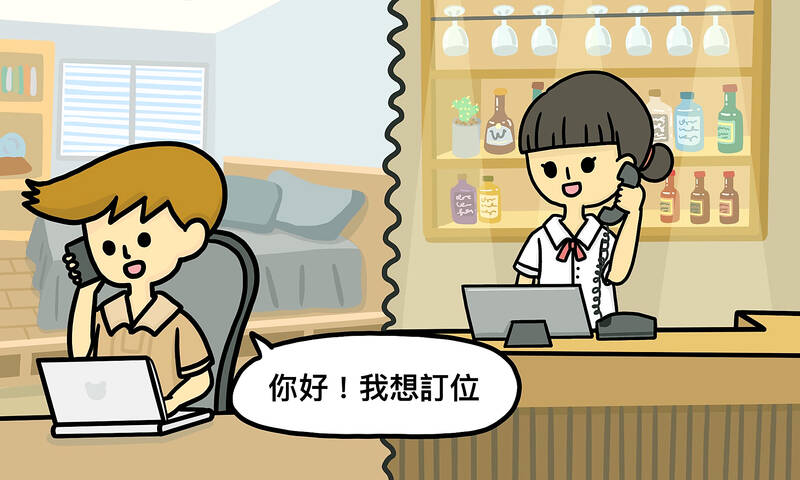對話 Dialogue
馬克:你好!我想訂位。
Make: Nǐ hǎo! Wǒ xiǎng dìngwèi.

餐廳服務生:好,請問您有幾位?訂什麼時候?
Cāntīng fúwùshēng: Hǎo, qǐngwèn nín yǒu jǐ wèi? Dìng shénme shíhòu?
馬克:我們有五個人,我要訂五月十四號的中午十二點半。
Make: Wǒmen yǒu wǔ ge rén, wǒ yào dìng wǔ yuè shísì hào de zhōngwǔ shí’èr diǎn bàn.
餐廳服務生:好的,請問您怎麼稱呼?
Cāntīng fúwùshēng: Hǎo de, qǐngwèn nín zěnme chēnghū?
馬克:我叫馬克,馬鈴薯的馬、巧克力的克。
Make: Wǒ jiào Mǎkè, mǎlíngshǔ de “mǎ”, qiǎokèlì de “kè”.
餐廳服務生:好的,馬克先生,方便留下您的聯絡電話嗎?
Cāntīng fúwùshēng: Hǎo de, Mǎkè xiānshēng, fāngbiàn liú xià nín de liánluò diànhuà ma?
馬克:我的電話是2538-1111。
Make: Wǒ de diànhuà shì 2538-1111.
餐廳服務生:好的,這樣就可以了!五月十四號見。
Cāntīng fúwùshēng: Hǎo de, zhèyàng jiù kěyǐ le! Wǔ yuè shísì hào jiàn.
翻譯 Translation
Mark: Hello! I want to make a reservation.
Waitress: OK, for how many? And what time would you like to reserve?
Mark: There are five of us, and I want to make an appointment for 12:30 on May 14.
Waitress: OK, what’s your name (what should I call you)?
Mark: My name is M?ke (Mark), “m?” as the character in m?lingsh? (potato), and “ke” as the character in qi?okeli (chocolate).
Operator: OK, Mr. Mark. Could you please leave your contact number?
Mark: My phone number is 2538-1111.
Operator: OK, that’s fine. See you on May 14.
單字片語 Vocabulary
1. 訂位 (dìngwèi) to book, to make a reservation
2 . 半 (bàn) half
3. 稱呼 (chēnghū) to call, to address
4 . 馬鈴薯 (mǎlíngshǔ) potato
5. 留下 (liú xià) to leave
6 . 聯絡電話 (liánluò diànhuà) contact number
7 . 這樣 (zhèyàng) like this
教材音檔 Audio Files
教材影片 Video Files:
https://www.instagram.com/celc.nou_tw/guide/_/17999106352646292/
實踐大學華語中心提供
By Shih Chien University Chinese Language Center: https://chineseusc.com/

In most cities, food waste is often regarded as one of the most troublesome types of waste: it has a high moisture content, spoils easily and produces strong odors. If not handled properly, it can cause serious sanitation and environmental problems. From the perspective of the circular economy, however, food waste is not “useless leftovers,” but rather an organic resource that has yet to be effectively utilized. The core principle of the circular economy is to break away from the linear model of “production–consumption–disposal,” allowing resources to circulate repeatedly within a system and extending their useful life. Food waste occupies a

A: Google has unveiled its 2025 Year in Search chart. No. 10 to No. 6 are: Typhoon Podul, Chinese drama “Love’s Ambition,” tariffs, US President Donald Trump and singer Khalil Fong’s death. B: Wow, actress Rosy Zhao’s new drama is so popular. So what are the top five? A: No. 5 to No. 1 are: Gemini, hanzii.net, NT$10,000 cash handout, entertainer Big S’ death and earthquakes. B: Hasn’t Trump topped this year’s most-searched people chart? A: Yup, and he’s closely followed by cheerleader GuoGuo Chiang at No. 2, whose husband Zack Fanchiang is also at No. 8. Apparently, people are curious about her extramarital

In June, headlines shocked the art world when a visitor damaged a 17th-century painting at the Uffizi Galleries in Florence, Italy, while posing for a photograph. This was not an isolated event. Recently, similar disasters have been reported worldwide, from a child damaging a Mark Rothko painting to a tourist breaking an exhibit by pretending to sit on it. Such incidents highlight why museum etiquette is increasingly crucial. First, we must recognize that art and historical objects are fragile. Once damaged, they may never regain their original condition. Many common actions, though harmless at first glance, can have grave consequences. For

A: Compared to Taiwanese, what did Americans search for most in 2025? B: No. 10 to No. 6 are: Tariffs, FIFA Club World Cup, government shutdown, DeepSeek and incoming New York mayor Zohran Mamdani. A: Mamdani is set to take office on Jan. 1. And what are the top five? B: No. 5 to No. 1 are: the One Big Beautiful Bill Act, iPhone 17, Labubu doll, animated blockbuster KPop Demon Hunters and political activist Charlie Kirk’s assasination. A: The only term to appear on both the Taiwanese and US charts is tariffs. A: 跟台灣人相比,美國人都在搜尋什麼? B: 第10到6名是:關稅、FIFA俱樂部世界盃、政府關閉、DeepSeek語言模型、候任紐約市長佐蘭曼達尼。 A: 曼達尼元旦即將就任,前5名是什麼? B: 第5到1名是:《大而美法案》、iPhone 17、拉布布玩偶、動畫片《KPop獵魔女團》、政治活動家查理柯克遇刺。 A: 看來台、美熱搜榜唯一的共同議題就是--關稅! (By Eddy Chang, Taipei